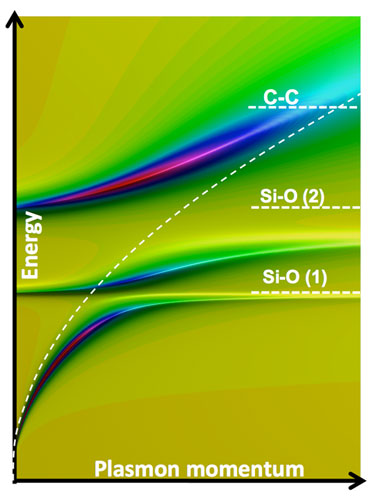IBM researchers are the first to have studied how plasmons lose their energy in graphene. The work could help in the development of carbon-based optoelectronics devices, such as plasmonic waveguides, modulators and detectors that work in the technologically important sub-terahertz to mid-infrared part of the electromagnetic spectrum.
A team led by Phaedon Avouris and Fengnian Xia of IBM s TJ Watson Research Center in New York studied graphene nanoribbons, dots and nanodisk arrays grown on a variety of substrates, such as SiO2 and diamond-like carbon, atop highly resistive silicon wafers. Graphene (a 2D sheet of carbon arranged in a honeycombed lattice) absorbs light by confining it into regions that are hundreds of times smaller than the wavelength of the light by exploiting plasmons that occur within the individual ribbons, dots and nanodisks. Plasmons are quantized collective oscillations of electrons that interact strongly with light. Such enhanced interaction could be exploited in a wide range of technologies, such as light detection and modulation, optical communications, photovoltaics and spectroscopy, to name but a few.
Graphene could well be a very promising plasmonic material thanks to the material s unusual electronic properties, which result in its electrons moving extremely fast and behaving like relativistic Dirac particles with virtually no rest mass. Graphene absorbs light particularly well in the terahertz and infrared parts of the electromagnetic spectrum – something that could lead to novel applications in photonics and quantum optics. What is more, plasmons appear to lose their energy (or decay) very slowly in graphene, which is important for such applications because the longer the plasmons last the better.
Plasmons last in graphene
Until now, however, no-one had ever really studied how plasmons lose their energy in graphene. Avouris and colleagues have measured the light transmission spectrum of their graphene nanostructures (which are less than 50 nm wide and produce plasmons in the mid-infrared range of 4–15 µm) using a Fourier transform IR spectrometer. The technique has allowed the researchers to measure exact plasmon damping mechanisms and rates, as well as how quickly the plasmons actually decay in the carbon material.
So what did they find? We observed a strong new damping mechanism when the plasmon energy crosses the intrinsic carbon-carbon vibrational (phonon) energy of graphene at about 200 meV, said Avouris. We also found plasmon lifetimes of 20 fs or shorter where emission of such a phonon is possible.
And that is not all: the researchers say that scattering of plasmons at the edges of the nanostructures provides another important damping channel and they even succeeded in measuring the rates of these processes as a function of phonon energy.
Most importantly of all, however, we found that the graphene plasmons appear to interact strongly with the vibrations of the silicon dioxide substrate surface atoms on which the graphene is deposited, Avouris told nanotechweb.org. This interaction leads to so-called energy-dependent hybrid plasmon-phonon modes that disperse and decay very differently compared with those modes where graphene is deposited on non-planar diamond-like substrates.
Such a study will be particularly relevant for making optoelectronics devices, such as graphene waveguides, modulators and detectors that work in the sub-terahertz to mid-infrared, he adds.
The work is detailed in Nature Photonics.

